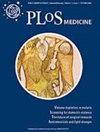Postmarketing active surveillance of myocarditis and pericarditis following vaccination with COVID-19 mRNA vaccines in persons aged 12 to 39 years in Italy: A multi-database, self-controlled case series study
IF 9.9
1区 医学
Q1 MEDICINE, GENERAL & INTERNAL
引用次数: 20
Abstract
Objectives To investigate the association between SARS-CoV-2 mRNA vaccines, BNT162b2 and mRNA-1273, and myocarditis/pericarditis. Design Self-Controlled Case Series study (SCCS) using national data on COVID-19 vaccination and emergency care/hospital admissions. Setting Italian Regions (Lombardia, Friuli Venezia Giulia, Veneto, Lazio). Participants 2,861,809 individuals, aged 12-39 years, vaccinated with the first doses of mRNA vaccines (2,405,759 BNT162b2 and 456,050 mRNA-1273) between 27 December 2020 and 30 September 2021. Main outcome measures First diagnosis of myocarditis/pericarditis within the study period. The incidence of events in the exposure risk periods (0-21 days from the vaccination day, subdivided in three equal intervals) for first and second dose was compared with baseline period. The SCCS model was fitted using conditional Poisson regression to estimate Relative Incidences (RI) and Excess of Cases (EC) per 100,000 vaccinated by dose, age, gender and brand. Results During the study period, 441 participants aged 12-39 years developed myocarditis/pericarditis (346 BNT162b2 and 95 mRNA-1273). During the 21-day risk interval there were 114 cases of myocarditis/pericarditis (74 BNT162b2 and 40 mRNA-1273) corresponding to a RI of 1.27 (0.87-1.85) and 2.16 (1.50-3.10) after first and second dose, respectively. An increased risk of myocarditis/pericarditis at (0-7) days was observed after first [RI=6.55; 95% Confidence Interval (2.73-15.72); EC per 100,000 vaccinated=2.0 (1.5-2.3)] and second dose [RI=7.59 (3.26-17.65); EC=5.5 (4.4-5.9)] of mRNA-1273 and after second dose of BNT162b2 [RI=3.39 (2.02-5.68); EC=0.8 (0.6-1.0)]. In males, an increased risk at (0-7) days was observed after first [RI=12.28, 4.09-36.83; EC=3.8 (3.1-4.0)] and second dose [RI=11.91 (3.88-36.53); EC=8.8 (7.2-9.4)] of mRNA-1273 and after second dose of BNT162b2 [RI=3.45 (1.78-6.68); EC=1.0 (0.6-1.2)]. In females, an increased risk at (0-7) days was observed after second dose of BNT162b2 [RI=3.38 (1.47-7.74); EC=0.7 (0.3-0.9)]. At (0-7) days an increased risk following second dose of BNT162b2 was observed in the 12-17 years old [RI=5.74, (1.52-21.72); EC=1.7 (0.7-1.9)] and in 18-29 years old [RI=4.02 (1.81-8.91); EC=1.1 (0.6-1.3)]. At (0-7) days an increased risk after first [RI=7.58 (2.62-21.94); EC=3.5 (2.4-3.8)] and second [RI=9.58 (3.32-27.58); EC=8.3 (6.7-9.2)] dose of mRNA-1273 was found in 18-29 years old and after first dose in 30-39 years old [RI=6.57 (1.32-32.63); EC=1.0 (0.3-1.1)]. Conclusions This population-based study indicates that mRNA vaccines were associated with myocarditis/pericarditis in the population younger than 40 years, whereas no association was observed in older subjects. The risk increased after the second dose and in the youngest for both vaccines, remained moderate following vaccination with BNT162b2, while was higher in males following vaccination with mRNA-1273. The public health implication of these findings should be weighed in the light of the overall efficacy and safety profile of both vaccines.意大利12 - 39岁人群接种COVID-19 mRNA疫苗后心肌炎和心包炎上市后的主动监测:一项多数据库、自我控制的病例系列研究
目的探讨SARS-CoV-2 mRNA疫苗、BNT162b2和mRNA-1273与心肌炎/心包炎的关系。使用COVID-19疫苗接种和急诊/住院的国家数据设计自控病例系列研究(SCCS)。设置意大利地区(伦巴第,弗留利,威尼斯朱利亚,威尼托,拉齐奥)。参与者2,861,809人,年龄在12-39岁之间,在2020年12月27日至2021年9月30日期间接种了第一剂mRNA疫苗(2,405,759 BNT162b2和456,050 mRNA-1273)。主要观察指标研究期间首次诊断心肌炎/心包炎。将第一次和第二次剂量暴露风险期(从接种疫苗日起0-21天,细分为三个相等间隔)的事件发生率与基线期进行比较。SCCS模型采用条件泊松回归拟合,以按剂量、年龄、性别和品牌估计每10万人接种疫苗的相对发病率(RI)和超额病例(EC)。结果在研究期间,441名年龄在12-39岁的参与者发生心肌炎/心包炎(346例BNT162b2和95例mRNA-1273)。在21天的危险间期,第一次和第二次给药后,有114例心肌炎/心包炎(74例BNT162b2和40例mRNA-1273),对应的RI分别为1.27(0.87-1.85)和2.16(1.50-3.10)。第一次治疗后(0-7)天发生心肌炎/心包炎的风险增加[RI=6.55;95%置信区间(2.73-15.72);每10万接种者EC =2.0(1.5-2.3)]和第二剂[RI=7.59 (3.26-17.65)];第二次给药BNT162b2后,EC=5.5 (4.4 ~ 5.9), RI=3.39 (2.02 ~ 5.68);电子商务= 0.8(0.6 - -1.0)]。在男性中,第一次发病后(0-7)天风险增加[RI=12.28, 4.09-36.83;EC=3.8(3.1-4.0)]和第二次剂量[RI=11.91 (3.88-36.53)];第二次给药BNT162b2后,EC=8.8 (7.2 ~ 9.4), RI=3.45 (1.78 ~ 6.68);电子商务= 1.0(0.6 - -1.2)]。在雌性中,第二次注射BNT162b2后(0-7)天的风险增加[RI=3.38 (1.47-7.74);电子商务= 0.7(0.3 - -0.9)]。在(0-7)天观察到12-17岁儿童在第二次给药BNT162b2后风险增加[RI=5.74, (1.52-21.72);EC=1.7(0.7 ~ 1.9), 18 ~ 29岁[RI=4.02 (1.81 ~ 8.91)];电子商务= 1.1(0.6 - -1.3)]。在(0-7)天,首次发病后风险增加[RI=7.58 (2.62-21.94);EC = 3.5(2.4 - -3.8)]和第二(RI = 9.58 (3.32 - -27.58);18 ~ 29岁和30 ~ 39岁首次给药后,出现了EC=8.3(6.7 ~ 9.2)的mRNA-1273剂量[RI=6.57 (1.32 ~ 32.63)];电子商务= 1.0(0.3 - -1.1)]。结论:这项基于人群的研究表明,mRNA疫苗与40岁以下人群的心肌炎/心包炎相关,而在老年受试者中未观察到相关。接种两种疫苗后,第二次接种后风险增加,接种BNT162b2疫苗后风险保持中等,而接种mRNA-1273疫苗后男性风险更高。这些发现对公共卫生的影响应根据这两种疫苗的总体有效性和安全性进行权衡。
本文章由计算机程序翻译,如有差异,请以英文原文为准。
求助全文
约1分钟内获得全文
求助全文
来源期刊

PLoS Medicine
医学-医学:内科
CiteScore
21.60
自引率
0.60%
发文量
227
审稿时长
3 months
期刊介绍:
PLOS Medicine aims to be a leading platform for research and analysis on the global health challenges faced by humanity. The journal covers a wide range of topics, including biomedicine, the environment, society, and politics, that affect the well-being of individuals worldwide. It particularly highlights studies that contribute to clinical practice, health policy, or our understanding of disease mechanisms, with the ultimate goal of improving health outcomes in diverse settings.
Unwavering in its commitment to ethical standards, PLOS Medicine ensures integrity in medical publishing. This includes actively managing and transparently disclosing any conflicts of interest during the reporting, peer review, and publication processes. The journal promotes transparency by providing visibility into the review and publication procedures. It also encourages data sharing and the reuse of published work. Author rights are upheld, allowing them to retain copyright. Furthermore, PLOS Medicine strongly supports Open Access publishing, making research articles freely available to all without restrictions, facilitating widespread dissemination of knowledge. The journal does not endorse drug or medical device advertising and refrains from exclusive sales of reprints to avoid conflicts of interest.
 求助内容:
求助内容: 应助结果提醒方式:
应助结果提醒方式:


